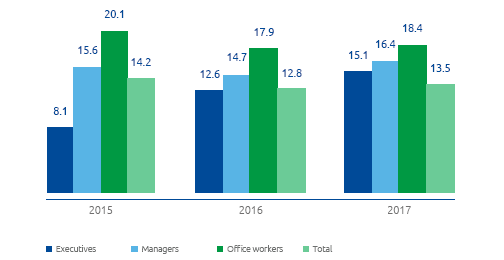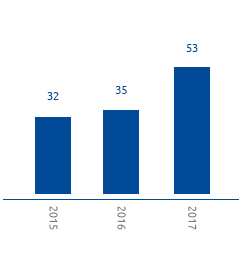Development of human, social and relationship, and intellectual capital
Employment in times of change
To continue to play a key role within a dynamic environment while continuing to lead in an international market abundant in challenges and opportunities, it is necessary to become an integrated player capable of enhancing know-how and meeting new challenges in the regulated and free market alike.
The new organisational structure of Snam, inspired by the one company model, was founded with the aim of creating centres of expertise and facilitating collaboration between the structures. People are called to more effectively share experiences and skills guided by the logic of entrepreneurship, simplification and capacity for implementation. This means working more in a team towards a single goal: all determining factors to create innovation and bring value to the company. The strong sense of belonging to the Group makes it possible to actively engage all employees in continuous improvement, which is increasingly driven by an entrepreneurial spirit, simplification and implementation capacity. For this and to face the new challenges, the new People Strategy was created and the new values of Snam were defined.
In this way, Snam will continue to generate “good employment”, characterised by stable and continuous work relationships for qualified and specialised activities. Moreover, through the Snam Institute, the Company intends to enhance the skills not only within the company but also outside.
As of 31 December 2017, out of a total of 2,919 people in service, 94% have an open-ended employment contract, including part-time employment contracts, which were 42 at the end of 2017. The average age of Group employees is 45.7, while the average length of employment is around 21 years, unchanged from the previous year.
| Download XLS (16 kB) |
|
2015 |
2016 |
2017 |
Executives |
99 |
87 |
93 |
Managers |
449 |
421 |
456 |
Office workers |
1,736 |
1,651 |
1,655 |
Manual workers |
721 |
724 |
715 |
Total employee |
3,005 |
2,883 |
2,919 |
| Download XLS (16 kB) |
|
2015 |
2016 |
2017 |
Permanent contract |
2,779 |
2,631 |
2,755 |
Apprenticeship or internship contract |
171 |
206 |
150 |
Fixed-term contract |
1 |
1 |
14 |
Part-time contract |
54 |
45 |
42 |
| Download XLS (16 kB) |
|
2015 |
2016 |
2017 |
Hired from the market (total) |
162 |
141 |
148 |
- of which university graduates |
75 |
73 |
100 |
- of which high school graduates |
86 |
66 |
48 |
- of which women |
32 |
35 |
53 |
Other new employees (non-consolidated companies, tender acquisitions, etc.) |
4 |
36 |
36 |
Demographic diversity: employees per age bracket (no.)

Absenteeism rate (%)

Staff turnover (%)

For the purposes of calculating the employee absenteeism rate, all hours worked (paid and unpaid) were excluded, excluding holidays and recoveries. The unprocessed hours of managers were not considered.
Development of roles and skills
With the new People Strategy the model of Leadership has been updated with the fundamental objective of enhancing people, increasing involvement and promoting the culture of innovation and change.
In particular, in 2018 Snam will focus on improving leadership skills by implementing the new skills model, maintaining solid and structured succession plans, identifying and enhancing talent throughout the organisation, to guarantee a sustainable succession line and intensify the level of engagement.
In 2017, the use of the Performance Management objective assignment and evaluation system was also confirmed, which also contains objectives on behavioural aspects and sustainability issues, including those relating to accident prevention at work. All assessment processes are formalised and include a feedback interview, which constitutes an institutional moment for exchange and communication between the manager and the employee, also in order to gather information that can be used to define new actions for the development and enhancement of people.
Also in 2017, in view of the 2018 performance cycle, a redesign of the company’s performance management system was launched with a view to optimising the current process of assigning and assessing the objectives.
All jobs within Snam, Snam Rete Gas, GNL Italia and Stogit are subject to an analytical and overall evaluation of Complexity, Responsibility, Experience and Autonomy (C.R.E.A.) factors. In 2017, 238 CREA assessments were approved. All assessment processes adopted are formalised and include a feedback interview, which constitutes an institutional moment for exchange and communication between the manager and the employee, also in order to gather information that can be used to define new actions for the development and enhancement of people.
The compensation systems are periodically updated based on a comparison with the reference pay markets and criteria inspired by meritocracy and internal equity, as well as in consideration of indications received from external stakeholders. n particular, these systems are meant to ensure recognition of the results achieved, a link with shareholder interests, the quality of the professional contribution provided and individual development potential.
Professional enhancement
Training is another essential element for supporting the processes of organisational integration and change management, and for enriching the employment opportunities of Snam personnel.
In 2017, a total of 85,346 hours of training were provided (an average of 29.2 hours per employee), with 8,604 participants and a participation rate of 75%, testimony to Snam’s ongoing and wide-reaching commitment to updating and developing its employees’ expertise. The involvement rate decreased compared to previous years because there were more training initiatives dedicated to specific employee targets.
In 2017, training also included differentiated courses targeted to meet specific needs, based on a segmentation of the company population horizontally, by role and professional family, as well as vertically, by level of responsibility.
A significant commitment was dedicated to worker training programmes regarding sensitive issues such as health, safety and the environment, by organising a number of meetings to provide updates and information and raise awareness amongst all professional figures with respect to the implementation of safety measures.
To favour accurate information and the application of the principles set forth in the Model 231, the Code of Ethics and Anti-corruption legislation, specific training activities were carried out for specific segments of the corporate population.
As regards training on the Code of Ethics, Model 231 and anti-corruption, a total of 327 hours of training were provided to 112 participants in 2017.
| Download XLS (16 kB) |
|
2015 |
2016 |
2017 |
Executives |
2,744 |
2,940 |
1,908 |
Managers |
11,143 |
10,021 |
8,600 |
Office workers |
41,763 |
31,072 |
39,316 |
Manual workers |
31,970 |
38,151 |
35,522 |
Total |
87,620 |
82,184 |
85,346 |
| Download XLS (15 kB) |
Description |
Hours provided |
Participants |
Recipients |
Technical training |
66,576 |
5,543 |
Office and manual workers |
Health, safety, environment and quality |
9,675 |
1,702 |
Corporate population |
Managerial training |
5,853 |
1,096 |
Executives, Managers |
Corporate welfare and work-life balance
Corporate welfare is a powerful tool that is integrated and integrated with the public welfare system and which attempts to respond to new social risks. Corporate welfare refers to a multiplicity of interventions, both monetary and in the form of services, which on the one hand generate benefits for employees who see increasing social protection and purchasing power, on the other they become a lever fundamental for companies, which benefit from a better working and productive climate.
Precisely to promote a positive work environment, over the years Snam has created a welfare system that draws on a long tradition of attention to people. It grows and changes over the years with the aim of meeting the emerging needs and requirements of the different sections of the corporate population. The in-depth analysis of the population, different needs and sensitivities, periodically updated, allows Snam to develop a shared, functional and effective welfare system.
Today the Snam Welfare system is a mix of tradition and innovation, whose structure includes actions to support employees in daily practices in traditional areas, such as Family, Health and Savings, and new proposals, also created as a result of agreements with trade unions, to better respond to the need for a work-life balance.
Snam’s corporate welfare system is constantly evolving in order to get closer and closer to the real needs of individuals.
The first group consists of all health and welfare support operations (cancer prevention, WHP Program), study and work orientation for employees’ children, parenting support operations (nursery reimbursements, summer camps, SOS Family), mobility (TPL subscriptions, shuttles, mobility portal) and micro-financing.
The “Welfare Award” (part of the Participation Award can be converted to services) and the Smart Working project are part of the second group.
With the “Welfare Award” it will be possible, as an alternative to fully paying the individual amount of the Participation Award, to voluntarily choose whether to convert a percentage of the usable Welfare Credit Award for oneself or for one’s family members.
The welfare system also includes:
- insurance against workplace and non-work-related accidents additional to the mandatory insurance;
- supplementary healthcare assistance covering public and private healthcare and hospital expenses;
- complementary pension funds, which in most cases are topped up by employer contributions.
Diversity
Snam respects everyone’s dignity, and offers equal opportunities throughout all phases and for all aspects of the employment relationship, avoiding all forms of discrimination based on sex, age, health, nationality, political opinion or religious views.
For Snam, diversity is a value and, in particular, great attention is paid to gender diversity which is considered a resource for the development of the company.
This is proven by the fact that, despite a large part of our business activities, in particular the operational ones, requiring technical training which on the market is predominantly found amongst men, female representation has gone up in 2017 compared to the previous year.
In 2017, female representation in the company consisted of 393 individuals (+6.5% compared to 2016), constituting 13.5% of all employees (12.8% in 2016).
The growth in female representations is still a corporate objective for 2018 with the commitment to recruit at least 50% of women in staff positions.
In order to make the most of diversity, in 2017 Snam became a Contributing Member of Valore D, the first association of companies promoting diversity, talent and female leadership for the growth of companies and the country. This collaboration has given its employees the opportunity to access courses for the enhancement of gender, generational and cultural diversity and for developing an inclusive culture, which is a factor of innovation, competitiveness and growth for people and companies. During the year, 40 employees (80% women) participated in over 20 courses.
Furthermore, the Group employs 126 disabled people, whose path of development aims to favour their inclusion and integration in company processes.
| Download XLS (15 kB) |
|
2015 |
2016 |
2017 |
Average hours of training provided to men (hours/year) |
30.9 |
30.2 |
31.3 |
Average hours of training provided to women (hours/year) |
18.4 |
17.0 |
15.8 |
Total female presence and by qualification (%) and Women hired by the market (no.)
Female presence (%)

Women hired by the market (no.)

Pay gap (women/men)
Pay gap (women/men)
